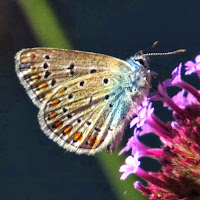 |
| Autumn plant fair at Blaye (Gironde) |
After the dryness of high summer, it's a relief to have some rain and the opportunity to move plants into different places. If she's not rearranging furniture in the sitting room, Christina enjoys nothing more than a good garden makeover - or a 'relooking' as they would term it over here!
Despite producing a quantity of peas and beans earlier in the year, our potager is just too small and shaded to be really successful as a veg plot; so we've decided to concentrate on herbs - those wonderful hyssops and salvias I wrote about last month - retaining a little area for raspberries.
Christina inclines towards the architectural side of gardening, and is much handier with a spade than me, so she started by digging out a proper gravelled path around the back of our new herb bed. It cuts down on growing space but makes it much easier to trim the hedge and access all parts of the new bed.
There are always some interesting stands at the Autumn foire aux plantes in Blaye, held inside the 17th century citadel overlooking the Gironde estuary, which is like a medieval village within the town, its rough stone and plaster walls providing a backdrop for seductive displays of plants and garden crafts.
The plant-sellers are drawn mainly from neighbouring departments and have become more practised at presentation over the years, ensuring that their specimens are well-labelled and even providing a photograph if there isn't an actual flower on show. Many of these horticultural enterprises now have informative websites and their plantsmen (and women) are always happy to talk at length to interested buyers - sometimes too happy it seems when you're left awkwardly clutching several pots, ready to hand over your cash whilst a long-winded discussion on soil types continues unabated, seemingly oblivious to impatient clients!
 |
| Eragrostis trichoides "Summer Strain" |
Another grass which catches the light beautifully is Pennisetum alopecuroides, or Chinese Fountain Grass, which is increasingly used to good effect in municipal flowerbeds and seems to come in varying shades of purple and brown.
 |
| Pennisetum alopecuroides "National Arboretum" |
After clearing away this tide of green, we can take the opportunity to turn the soil, add some home-made compost or leafmould, and tidy up the beds by re-defining their edges. Suddenly everything looks much sharper and the dazzling autumnal light really picks out those grasses.
Bright candy-pink sedums and deep blue plumbago flowers continue to dominate our borders; but as the sun sinks lower in the sky, there are more areas remaining in shade for much of the day and it's important to try and light up these darker corners.
This is where plants with variegated leaves come into their own, together with the berries of shrubs such as pyracantha - we have three varieities currently showcasing their berries: in scarlet, orange and yellow. Birds love them and they will probably all be devoured by Christmas.
 |
| Sternbergia lutea with Pyracanthus and Eleagnus pungens 'Maculata' |
Despite intimations of autumn, the garden does feel quite springlike in this moist but warm season, and it never fails to surprise us when bulbs like Sternbergia suddenly burst forth. Dormant for much of the year, their yellow crocus flowers light up the dry soil under trees and hedges; they quickly multiply and produce a great deal of glossy foliage - which is why they're probably better kept in out-of-the-way places!
Shrub of the Month - I would definitely nominate our Caryopteris clandonensis variegata (right) which has been in flower for most of September and is a magnet for bees. I took some seeds from this plant last year and grew three plants - two of them had plain green leaves and are flowering well, but the third one just has yellowish leaves and not a single flower.
Which probably goes to prove that I know nothing at all about Botany!!
But we do know how to keep our insects happy and have another 'nectar bar' in the mini-forest of Verbena bonariensis, which grows happily in the chalky base of our driveway. One late afternoon I counted four types of butterflies and one moth feasting on the bushy flowers, which are still going strong after eight weeks.
 |
| Brown Argus |
 |
| Hummingbird Hawkmoth |



